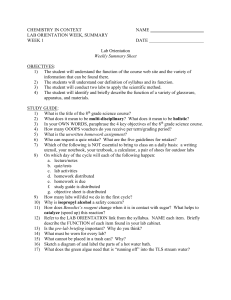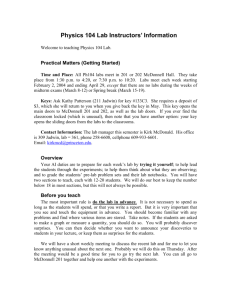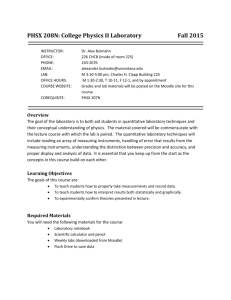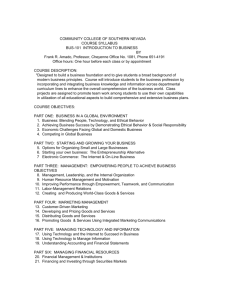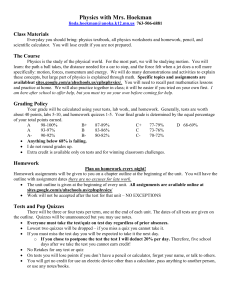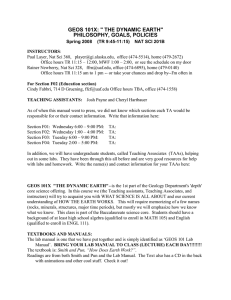Making Laboratories Count
advertisement
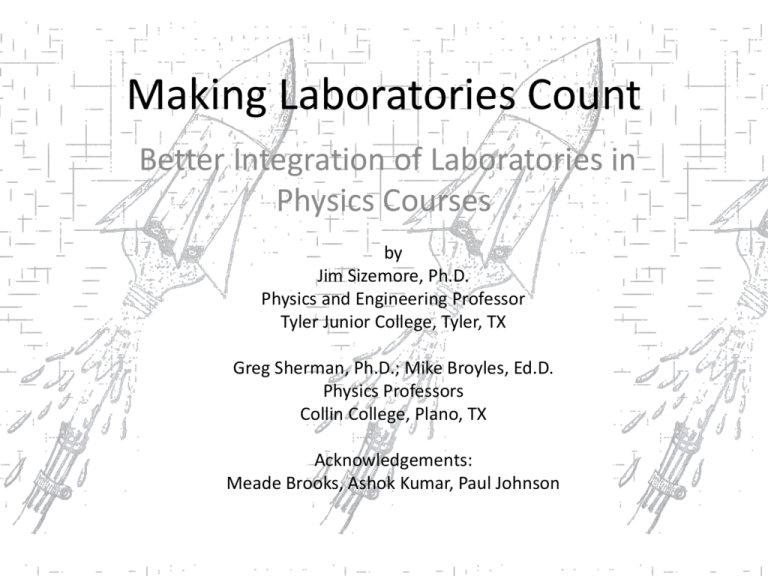
Making Laboratories Count Better Integration of Laboratories in Physics Courses by Jim Sizemore, Ph.D. Physics and Engineering Professor Tyler Junior College, Tyler, TX Greg Sherman, Ph.D.; Mike Broyles, Ed.D. Physics Professors Collin College, Plano, TX Acknowledgements: Meade Brooks, Ashok Kumar, Paul Johnson Outline of Talk • Issues – Students don’t take labs seriously – Poor math preparation • Solution – Prelab packets – Quiz on prelab – Objective grading of labs • Preliminary Results and Conclusions Students don’t take labs seriously • Informal survey of students – Admitted not preparing – Admitted expectation of good grade with only modest effort Poor Math Preparation • Course has Pre-Calculus Prerequisite • Gave Pre-Calculus Quiz at Start of Semester 1) What is the equation of the line that includes the points (9.1,9.5) and (-7.8,-4.8) 2) Solve for x: -0.54x2 + 13.53x – 25.53 = 0 3) Refer to the following figure. What is sin(), cos(), tan(), , and h? h 2.65 I 4) Solve for and calculate I: db =10log 10 where db = 27 and Io = 10-12 W/cm2. Io • Surprised by inability to answer questions – Didn’t expect result, thus did not keep records 1.07 Prelab Packets • Separated Lab into PreLab and Lab Components • Students were required to turn in Prelab at beginning of lab • Example on next slide Example Prelab Pre-Lab Quiz • Give Quiz at Beginning of Lab over Content of Pre-Lab – Insures students do pre-lab preparation – Insures on-time attendance • Quiz Asked Open Ended Questions. Examples: 1) The quantity mv is referred to as momentum and is conserved. In other words, when you add up the momentum of all the particles vector-wise before collision it equals the sum (vector-wise) of the momentums of all particles after collision. There is only one particle before collision with the pendulum – the steel ball. What is the expression for its momentum? 2) After it collides with the ballistic pendulum the two particles together have a momentum. What it the expression to the combined momentum of both after collision? – Grading Quizzes was Time Consuming – In Future Will Change to Multiple Choice Quizzes Objective Grading • Labs Often Taught by Inexperienced Instructors • Tendency to Judge Based on Scale of 1 to 10 • Solution: Precise Point Assignment on 0 to 100 Scale – Example from Previous Slide Example Prelab SOLVE Method • 5 Steps 1) Sketch or Study 2) Organize knowns and unknowns 3) Line up (equations) 4) Vary (get working equation) 5) Evaluate • Award 20% Credit for Each Step Completed • Per Arnold Arons – systematic approach is important Application of Bloom’s Taxonomy to Quantitative Fields • Get Away From Memorizing Equations • Bloom’s Taxonomy Simplified – Know – Understand – Apply – Synthesize – Critique • Award 20% for each step of Bloom’s Taxonomy Completed Other Grading Criteria • Tables and Graphs – 20% for accurate tabulation or graphing – 10% for equations – and labeling axes, showing units, etc. • Dimensional Analysis • Using Unit Fractions when Converting Units • 3 Sig. Figs or Better • Etc. – at http://www.funphysicist.net/physics_1401/labs/list.htm Results • Some Evidence of Improvement Through Semester • Overall Course Grade Grade (student estimate & actual) 12 estimated 10 8 6 4 2 0 A B C D F actual Results – Study Outside Class • Evidence of Greater Effort Outside Study 7 6 5 4 3 2 1 0 A B C A >3 hr, B ~3 hr, C ~2 hr, D ~1hr, F <1 hr D F Results – Lab Grades • Maybe Improvement Through Semester • However Inconclusive Lab Grade (percent vs. week) 120 Pre-Lab Grade (points vs. week) 120 100 100 80 80 60 60 40 40 20 20 0 0 1 2 3 4 5 6 7 8 9 10 11 12 13 1 2 3 4 5 Lab Quiz Grade (points vs. week) 12 10 8 6 4 2 0 1 2 3 4 5 6 7 8 9 10 11 12 6 7 8 9 10 11 12 Conclusions • Evidence of Better Student Engagement and Effort – Increased effort is appropriate – Underprepared students spend more time, however succeed • Grades Improve • Doesn’t Require New Labs or Rewrites – Develop grading scheme, break out pre-labs, develop multiple choice pre-lab quizzes • Results Not Unequivocal, but are Encouraging Future Work • Gather Statistics Over Several Semesters to Understand Variability due to Differences Between Labs • Retain Baseline Information of Beginning of Semester Quiz to Compare to Mid-Semester and End-of-Semester Data • Establish Control Group for Comparison
